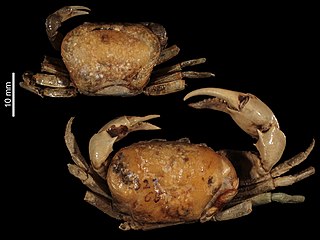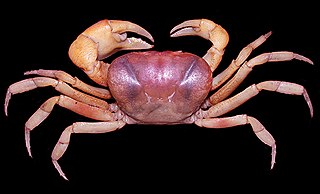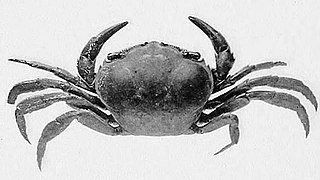
Xanthidae is a family of crabs known as gorilla crabs, mud crabs, pebble crabs or rubble crabs. Xanthid crabs are often brightly coloured and are highly poisonous, containing toxins which are not destroyed by cooking and for which no antidote is known. The toxins are similar to the tetrodotoxin and saxitoxin produced by puffer fish, and may be produced by bacteria in the genus Vibrio living in symbiosis with the crabs, mostly V. alginolyticus and V. parahaemolyticus.

Austrothelphusa is a genus of freshwater crab endemic to Australia, comprising the following species:

Mictyris is a genus of brightly coloured crabs, placed in its own taxonomical family, the Mictyridae. It inhabits the central Indo-West Pacific region. These crabs congregate on mud flats or beaches in groups of a few thousand, and filter sand or mud for microscopic organisms. They congregate during low tide, and bury themselves in the sand during high tide or whenever they are threatened. This is done in wet sand, and they dig in a corkscrew pattern, leaving many small round pellets of sand behind them.

Tuerkayana hirtipes is a species of terrestrial crab.

The stalk-eyed mud crab is a marine large-eyed crab of the family Macrophthalmidae, endemic to New Zealand including Campbell Island. It grows to around 30 millimetres (1.2 in) shell width. It is either the only species in the subgenus Hemiplax and the most basal species in the genus Macrophthalmus, or the only species in the sister genus Hemiplax.

The Bythograeidae are a small family of blind crabs which live around hydrothermal vents. The family contains 16 species in six genera. Their relationships to other crabs are unclear. They are believed to eat bacteria and other vent organisms. Bythograeidae are a monophyletic, sister taxon of the superfamily Xanthoidea which split to inhabit hydrothermal vents around the Eocene.

Discoplax is a genus of terrestrial crabs. It is very closely related to the genera Cardisoma and Tuerkayana.

Parathelphusinae is a subfamily of freshwater crabs, which was formerly placed in the family Parathelphusidae; they are mainly found in South and Southeast Asia, but also found elsewhere in Asia and in Australia. The family is now considered as a junior synonym of the family Gecarcinucidae.

Chiromantes haematocheir, commonly known as red-clawed crab, is a species of mudflat crab in the family Sesarmidae. It is endemic to East Asia and is quite distinct from the other species placed in the genus Chiromantes. The genus may be restricted to this one species.

Deckenia is a genus of freshwater crabs from East Africa, in the family Potamonautidae, or sometimes in a family of its own, Deckeniidae. The genus was named by Hilgendorf after Karl Klaus von der Decken who collected the first examples during his expeditions to Africa. Both species live in swamps from Eyl in Somalia to Dar es Salaam, Tanzania, both in coastal areas and further inland. A third species, Deckenia alluaudi, lives in the Seychelles, and has been transferred to a separate genus, Seychellum.

Johora is a genus of freshwater crabs found in the Malay Peninsula and surrounding islands. It includes the following species:

Amarinus lacustris is a species of freshwater crab from Australia, New Zealand and nearby islands, where it lives in water of various salinities. It grows up to 10 mm (0.4 in) wide, with an H-shaped groove on its back. It is an omnivore and is eaten by crayfish and fish. It was first discovered in Lake Pupuke, near Auckland, and is the only freshwater crab in New Zealand.
Brasiliothelphusa tapajoensis is a species of freshwater crabs in the family Pseudothelphusidae, and the only species in the genus Brasiliothelphusa. It was described in 1986 from specimens caught in the Rio Tapajós in the state of Pará, Brazil. It is listed as Data Deficient on the IUCN Red List.
Neoepilobocera gertraudae is a species of cave-dwelling crab from Cuba.
Prionothelphusa is a genus of freshwater crabs in the family Pseudothelphusidae, containing the single species Prionothelphusa eliasi. It lives in Colombia, Venezuela and Brazil in the drainages of the Rio Negro river draining the Guyana Shield, and is listed as Least Concern on the IUCN Red List.
Villalobosius is a genus of crabs in the family Pseudothelphusidae, containing a single species, Villalobosius lopezformenti. It lives in the northern part of the state of Oaxaca, Mexico, on the Isthmus of Tehuantepec, and is adapted to a troglobitic lifestyle.

Karstarma is a genus of karst-dwelling crabs formerly included in Sesarmoides.

Gelasimus vocans is a species of fiddler crab. It is found across the Indo-Pacific from the Red Sea, Zanzibar and Madagascar to Indonesia and the central Pacific Ocean. It lives in burrows up to 50 centimetres (20 in) deep. Several forms of G. vocans have been recognised, with their authors often granting them the taxonomic rank of full species or subspecies.
Hainanpotamon is a genus of freshwater crabs, containing the following species:
Mictyris guinotae is a species of soldier crab of genus Mictyris, endemic to the Ryukyu Islands of Japan. They were named after Danièle Guinot, a professor at the Muséum national d'histoire naturelle in France, and were first treated as a separate species in a tribute volume to Guinot.














